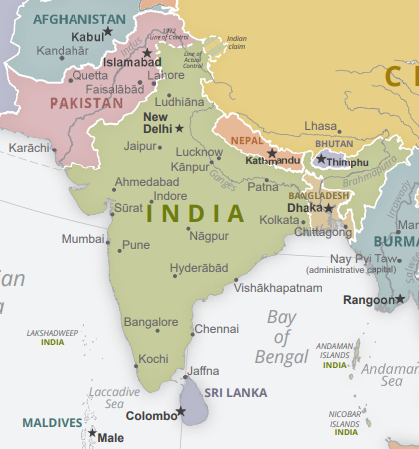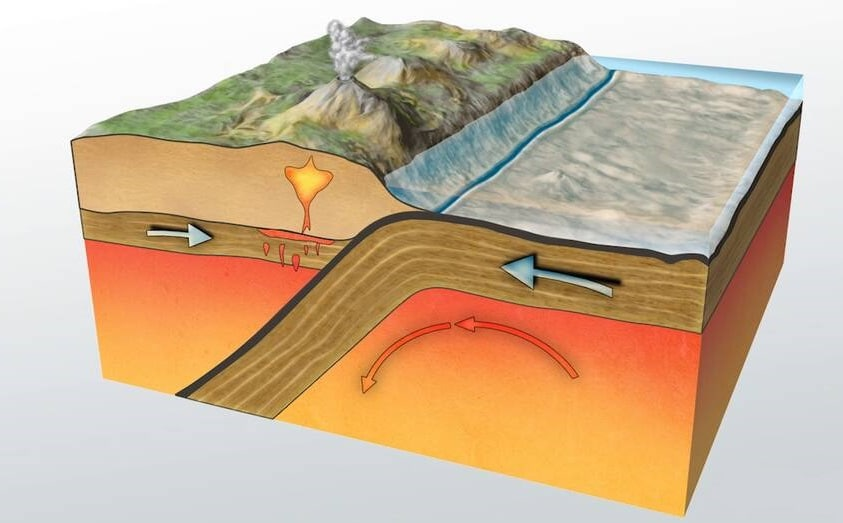Q. Do you agree that nature of landscape influences the pattern of human settlements? Elaborate with reference to Indian subcontinent.
The Influence
of Landscape on Human Settlements: A Case Study of the Indian Subcontinent
Human settlements are shaped by a multitude of
factors, ranging from social, cultural, economic, and political forces to the
natural environment. Among these, the landscape or geographical features of a
region play a crucial role in determining where and how human communities
settle. In the Indian subcontinent, the landscape has profoundly influenced the
pattern of human settlements throughout history. From the fertile plains of the
Ganges to the arid deserts of Rajasthan and the lush coastal regions, the
physical features of India have guided the choices of settlement sites,
influencing the distribution of populations, the growth of cities, and the
development of cultures. This complex relationship between the landscape and
human settlement patterns provides key insights into the evolution of the
subcontinent's historical, social, and economic structures.
1.
Geographical Diversity of the Indian Subcontinent
The Indian subcontinent is characterized by a
remarkable diversity of landscapes. It is bordered by the towering Himalayan
mountain range in the north, the expansive Thar Desert in the west, the fertile
river valleys in the north and east, and the tropical coastal regions in the
south. These diverse landforms have created varied ecological zones that
significantly affect the distribution of human populations. The primary
geographical features that influence settlement patterns include:
- The Himalayan mountains in the north,
- The Indo-Gangetic plain that stretches across the
northern and central regions,
- The Deccan Plateau in the south,
- The western and eastern coastal regions,
- The Thar Desert in the northwest, and
- The forests of central India and the northeastern
regions.
Each
of these regions has played a distinctive role in shaping where people have
lived, how they have interacted with their environment, and how settlements
have developed over time.
2. The Role of
Rivers in Shaping Settlement Patterns
Rivers have been central to the development of human settlements in the Indian subcontinent. Major river systems such as the Indus, Ganga, Brahmaputra, and Godavari have acted as lifelines for ancient and modern settlements. The availability of water from these rivers has not only provided sustenance but also facilitated agriculture, trade, and transportation, all of which are key elements in the establishment of thriving settlements.
·
The Indus River Valley (present-day Pakistan and northwest India) is one of
the most significant early examples of river-based settlements. The
civilization that flourished here, the Indus
Valley Civilization, was primarily situated along the banks of the
Indus River and its tributaries. The river provided fertile soil, which
supported agricultural activities, and it also offered a transportation route
for trade. The ancient cities of Mohenjo-Daro and Harappa are prime examples of
settlements organized around river systems, showing the early importance of
rivers in urban development.
·
The Ganges River is another major watercourse that has shaped human
settlements in India for millennia. The fertile plains of the Ganges have been
home to some of the most populous and culturally significant regions in the
country. The Ganges Basin has historically supported dense populations due to
its rich alluvial soil, which facilitates the cultivation of rice, wheat, and
other crops. Ancient cities like Varanasi
and Patna, and modern
metropolises like Kolkata, owe
their existence to the proximity of this river. The Ganges also plays a central
role in Hindu religious practices, making its banks sacred ground for millions
of people, further influencing settlement patterns.
·
The Brahmaputra River, running through the northeastern region of India,
has shaped the settlement patterns of Assam and the surrounding areas. The
river's floodplains offer fertile soil, while its numerous tributaries support
smaller settlements in the region. In addition, the river has facilitated trade
routes between India, Bangladesh, and other parts of Southeast Asia,
contributing to the growth of cities such as Guwahati and Tezpur.
These river systems have been crucial for agricultural
production, irrigation, and settlement in India, as they provide not only water
but also fertile lands for farming, which is the backbone of the economy in
many regions.
3. The Influence of Mountains and Plateaus
While rivers have encouraged settlement in fertile
plains, mountainous regions and plateaus have presented both challenges
and opportunities for human habitation.
·
The Himalayas, which stretch across the
northern boundary of the subcontinent, have historically acted as both a
barrier and a source of resources. The mountains themselves were difficult to
settle due to their steep terrain, harsh climates, and limited arable land.
However, the foothills of the Himalayas, particularly in states like Himachal Pradesh, Uttarakhand, and parts of Jammu and Kashmir, have been ideal
locations for small, dispersed villages that rely on agriculture and
pastoralism. These regions have also been centers of religious and cultural
significance, with pilgrimage towns such as Haridwar and Rishikesh
located along the foothills.
·
In the Deccan Plateau, which covers much of
southern India, the topography and climate have had a distinct influence on
human settlements. The plateau is generally characterized by volcanic soil,
which is rich in minerals but less fertile than the river plains of the north.
Despite these challenges, the region has supported large cities and prosperous
kingdoms throughout history, particularly in areas like Hyderabad, Bangalore, and Chennai.
The plateau's natural resources, including minerals and semi-arid farming
zones, have fostered growth, while its isolation from external invasions has
allowed some regions to flourish independently.
·
The Western Ghats and Eastern
Ghats, which run along the western and eastern coasts of India, have
also influenced settlement patterns. These mountain ranges are rich in
biodiversity and natural resources such as timber and minerals. While the
rugged terrain posed challenges for agriculture, the coastal plains on either
side provided fertile lands for cultivation. The region's accessibility to the
sea allowed trade with other parts of Asia and Africa, and cities such as Mumbai (formerly Bombay) and Chennai developed as important ports.
4. The Coastal and Island Regions
The western and
eastern coasts of India have supported human settlements for
centuries, particularly in the fertile plains that border the seas. The
presence of large rivers like the Mahi,
Narmada, and Godavari along the coasts, along with
the favorable tropical climate, has led to the development of thriving
agricultural communities.
·
Coastal regions
like Kerala in the southwest and
Tamil Nadu in the southeast are
particularly notable for their early human settlements, influenced by the
availability of resources from both land and sea. Kochi, Kochi,
and Chennai are cities that
evolved around their proximity to the coast, trading extensively in maritime
routes with Southeast Asia, the Middle East, and Africa.
·
The Andaman and Nicobar Islands and the Lakshadweep archipelago have also been
home to indigenous groups, but their settlements have traditionally been small
and confined to specific ecological niches. These regions were isolated for
much of history, with their settlements influenced by maritime resources and
their isolation from the mainland.
5. The Desert and Arid Regions
In contrast to the fertile river plains and coastal
areas, the Thar Desert in the
northwest is an example of how arid landscapes affect human settlements. The
harsh, dry conditions of the Thar Desert make large-scale agriculture
difficult. However, settlements like Jodhpur,
Jaisalmer, and Bikaner developed in this region due to
their strategic locations along trade routes and the availability of natural
resources like water from wells and underground aquifers.
These desert settlements were historically part of
caravan trade networks, and the fortifications built in cities like Jaisalmer reflect their role as
important trading hubs. Despite the harsh climate, the Thar Desert has
supported semi-nomadic populations, who rely on livestock herding and desert
agriculture, particularly the cultivation of drought-resistant crops.
6. Forests and Tribes
The central and northeastern regions of India are
heavily forested and have been historically less accessible than other parts of
the country. These areas have long been home to indigenous tribal communities
who have maintained distinct ways of life based on hunting, gathering, and
shifting agriculture. The dense forests of Madhya Pradesh, Chhattisgarh,
Orissa, and Jharkhand have provided resources for
these communities, who often live in small, dispersed villages.
In the north-east, the forested areas have supported
tribes who rely on rice cultivation, hunting, and fishing, with settlements
such as those in Nagaland and Meghalaya demonstrating the integration
of people with their natural environment.
7. Conclusion: The Interplay of Nature and Human
Settlements
In the Indian subcontinent, the nature of the
landscape has profoundly influenced the pattern and development of human
settlements. The availability of water from rivers, the fertility of plains,
the isolation or accessibility provided by mountains, and the resources
available in forests and deserts have all shaped where and how people settled.
From the river valley civilizations of the Indus and Ganga to the coastal
cities of the west and south, and from the arid regions of Rajasthan to the
dense forests of central India, the landscape has been a determining factor in the
development of India's diverse and rich tapestry of human settlements.
The relationship between landscape and human
settlements in India is not simply one of adaptation but also one of active
transformation. Humans have shaped the environment through irrigation,
agriculture, construction of cities, and trade, just as the environment has
influenced the distribution of settlements and the way in which people live.
This interplay between landscape and human settlement continues to shape
India's demographic, economic, and cultural patterns to this day.











0 comments:
Note: Only a member of this blog may post a comment.